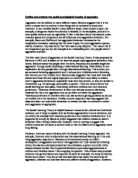Mead (1935) conducted a study on social groups in Papua New Guinea, providing evidence of cultural role differences and thus supporting the theory. She found that one tribe was gentle, responsive and cooperative, regardless of their gender. In another tribe, men and women were violent and aggressive and valued power and social position highly. By contrast, a third tribe showed gender role differences, the women were dominant, impersonal and managerial whereas the men were emotionally dependent. Mead’s study supports the influence of culture on gender roles as it shows that gender roles clearly vary depending on the culture in which an individual lives, even within the same country (such as Papua New Guinea), as depending on the culture of the individual (in this case, the tribe) the gender roles differed greatly, therefore supporting the role of culture on gender.
Another study, which supports the role of culture on gender roles, is Hargreaves (1986). He observed that in some cultures, men weave and women make pots, whereas in others, these roles are reversed; women are the major agricultural producers in some, but prohibited from agricultural work in others. Although women are sometimes not physically strong enough to perform agricultural work, this study shows the gendered division of labour varies considerably between cultures. Hargreaves work supports the influence of culture on gender roles as in different cultures, individuals had varying roles in division of labour showing that such roles were not culturally universal, therefore supporting the theory of cultural influence on gender roles.
A study, which contradicts the influence of culture on gender roles, is Barry et al. (1957). He performed research across many non-Westernised cultures, looking at which qualities were deemed important for males and females. Nurturing was seen as a dominantly feminine characteristic while self-reliance was seen in the same way for males. These findings are similar to Western perspectives of gender roles, suggesting universal generalisability. His study contradicts the influence of culture on gender roles as non-westernised and westernised cultures both had the same perception of what masculine and feminine characteristics were, for example feminine characteristics including nurturing. This suggests that culture does not have a big influence on gender roles and that they are likely to be universal.
The nature/nurture debate is an intrinsic aspect of Psychological theory. Nature refers to Gender being determined by innate factors, while nurture deems culture and social environment as responsible. The cultural perspective suggests that a persons gender is due completely to the environment they grow up in, that is, nurture. Therefore, the cultural approach only supports the nurture side of the debate, which does not address the role of nature, such as genetic makeup and hormonal influence. This limits the theories influence – as it is important to recognise that most human behaviour is due to both a combination of nature and nurture.
The influence of culture on gender roles and behaviours can be compared to the evolutionary perspective, in order to determine whether gender develops through our cultural environment or whether it’s universal. Evidence has shown that gender is culturally relative and thus behaviour, roles and division of labour varies widely between cultures. This can be seen in Mead’s research, which demonstrates the differences in how gender roles are divided cross culturally in Papua New Guinea communities. Conversely, evolutionary theory argues that gendered behaviours developed because they were advantageous mutations to each sex and thus gender roles and divisions of labour are argued to be universal. Evolutionary research, such as Barry’s (1957) study, therefore presents an issue for the argument that gender is culturally relative. As much research has shown there is some universality to gender roles and behaviours throughout the world, this would suggest there is an evolutionary basis to gender, which cultural research fails to explain. Overall, the debate into whether gender is universal, with roots in evolution, or culturally relative, is complex and the research is varied. The best approach would be to consider the complex phenomenon of gender as a combination of both evolutionary traits, which are shaped by cultural experience. In this way, an approach can account for all research and argument into the causes of gender around the world.








